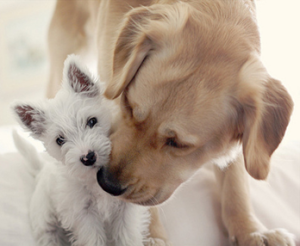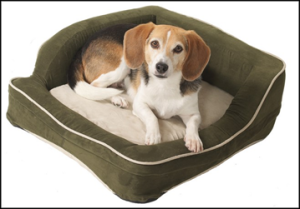
Puppies typically enjoy playing with other puppies and may not demonstrate any problem behaviors toward any other dog. Lange Animal Clinic veterinarians in Pekin, IL advise that in order to understand our dogs’ behavior toward other dogs, one must understand contributing factors toward the dog’s development from a puppy. For example, a dog’s behavior will highly depend upon its environment- it may change depending on the circumstances and other individuals involved.
The reality is that the world is not divided into dogs who are “good with other dogs” and those who are “not good with other dogs”. A particular dog can react aggressively if certain factors are present, just as any human can use verbal or physical aggression if instigated at various levels. These interactions between dogs are determined by factors during upbringing such as the quantity of dogs involved/interacted with, the location, and the level of interactivity and the ages of the dogs. Naturally, the behavior of each dog has an impact on all the others.
Lange Animal Clinic offers some guidelines to help adolescent/adult dogs behave and interact better with those around him/her:
- Try to avoid overly-excessive play situations. It is the rare adolescent dog who can remain calm and play appropriately when surrounded by other young, excited dogs. If your dog plays too roughly in these situations, remove him or her: select quieter, less stressing surroundings for him. Frequent the dog park only when fewer dogs are present, making sure that at least some of them are mature adults. Well-socialized adult dogs are valuable park-buddies for “teen” dogs, as they can teach them appropriate behavior without causing harm.
- Consistently provide interaction with your adolescent dog to well-behaved adult dogs. By definition, the phrase “well behaved” means the adult dog interacts well with young dogs but will interrupt unacceptable/rough behavior. Adult dogs typically use eye contact and tall, still postures to discourage unwanted contact. Interruptions normally consist of a quick, deep sound (not a confrontation) lasting several seconds. If the adult dog does go after the adolescent, this is inappropriate and must be interrupted.
- Continually enforce calm behavior. If you are taking a walk with your dog and are approaching a dog park or playgroup and your dog starts barking excessively, turn around and walk him/her away. Leave the area or venue abruptly. If your dog absolutely will not calm down, take him/her back home. This may seem mean at first, but preventing your dog from this type of overly excited behavior will pay off in the long run.
- Promote only desirable behavior with your dog. Keep in mind, behavior will strengthen with practice so be certain that your dog practices only positive behavior. Dependent upon the activity, always question whether or not the behavior is helping or hindering your dog’s interaction with others. Maybe going to the dog park is resulting in enjoyable and positive experiences in your dog or on the contrary- is it teaching Fido to chase and boss around every dog he or she sees? Does leaving your dog in the backyard is permit him/her to bark at or motion aggressively toward people or other dogs walking by? Be sure to choose new activities for your dog if his current ones are reinforcing bad habits.
- Enforce calming techniques to your dog. Consider leashing your dog while you enjoy a movie and ignore him or her. Should he or she jump on the couch into your lap, delicately move him or her away from you with the leash. Wait until he settles quietly on the floor, then quietly praise him. If he jumps up again, start over. Practicing this “Settle” exercise regularly will teach your dog that calm behavior is the way to get your attention.
Reinforcing positive behavior in your dog at an early age will promote positive behavior later down the road. Speak with a Lange Animal Clinic veterinarian for more ideas on how to help with behavioral training in your pets.
For over 45 years, Lange Animal Clinic has provided veterinary services in Pekin, IL and the surrounding areas for over three family generations. Our expert staff of Veterinarians, Veterinary Technicians, and Veterinary Assistants are trained to ensure the best quality medical care for your beloved pets-whether it be as a routine medical examination to more complicated surgical procedures. We are a small companion animal clinic providing services for dogs, cats, and exotic pets.
Dr. Colleen O’Rourke, owner and senior Doctor of Veterinary Medicine, takes great pride in making certain that every patient’s experience is handled with the utmost care, compassion, and economically in the best interests of our clients. Visit us at www.langeanimal.com.








